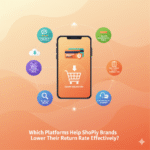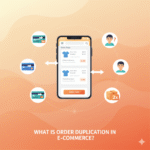If you’ve been running a Shopify store for a while, you already know that returns are part of the eCommerce game. Whether it’s sizing issues, product expectations, or shipping delays returns can’t be avoided entirely.
But what if I told you that in 2025, Shopify and its ecosystem of apps have made returns not just manageable but strategic? With the rise of flexible return workflows, Shopify merchants now have more control, visibility, and customization than ever before.
This guide breaks down:
- What return workflows mean in Shopify
- Why flexible returns are the future of eCommerce
- The best return solutions and apps in 2025
- How to set up flexible workflows in your store
- And what trends are shaping Shopify returns this year
Let’s get right into it.
What Are Shopify Return Workflows?
Return workflows define how your store handles returns from when a customer submits a request to when they get a refund, replacement, or store credit.
Traditionally, returns were a headache:
- Manual emails
- Confusing steps for customers
- Refunds taking weeks
Now, with automated and flexible workflows, Shopify allows you to:
- Approve returns automatically or based on conditions
- Offer exchanges or store credits instead of refunds
- Send automated notifications for every step
- Integrate with logistics and warehouse tools for faster processing
In short your return process becomes smart, efficient, and customer-friendly.
Why Flexible Return Workflows Matter in 2025
Customer expectations have evolved. Shoppers now expect seamless post-purchase experiences, not just fast deliveries.
Here’s why flexible workflows are crucial this year:
- They build customer loyalty:
A smooth return process makes customers more confident about purchasing again. - They reduce refund losses:
Flexible workflows encourage exchanges or store credits instead of cash refunds. - They save time for support teams:
Automated approvals and notifications reduce manual work. - They provide better data insights:
You can analyze why returns happen — sizing, quality, delivery, etc. — and fix them.
In 2025, return flexibility isn’t a luxury; it’s part of a winning eCommerce strategy.
What Makes a Return Workflow “Flexible”?
A flexible return workflow allows you to customize every stage of the return experience depending on your business type, product category, or customer profile.
Here’s what it usually includes:
- Custom Return Reasons: You decide what options customers see — “Too Small,” “Wrong Color,” “Damaged Item,” etc.
- Smart Approval Rules: Automatically approve low-value returns, but review expensive ones manually.
- Exchange Options: Let customers pick a different size or color instead of requesting a refund.
- Store Credit Incentives: Offer bonus credits (e.g., 10% extra) if customers choose store credit.
- Multiple Return Methods: Return to store, drop-off, or courier pickup — based on what suits them.
- Automated Workflows: Set conditions that trigger emails, refund actions, or updates without manual input.
Essentially, flexible workflows let you build a custom return system that matches your brand’s policies and customer needs.
Top Shopify Return Solutions in 2025 (with Flexible Workflow Features)
Let’s look at some of the best Shopify return platforms that provide flexible and automated workflows this year.
1. Loop Returns
Best for: Exchanges and store credit workflows
Loop is one of the most advanced Shopify return platforms, and in 2025 it has added even more flexibility.
Key Features:
- Visual return workflows — drag-and-drop customization.
- Automatically trigger exchanges or store credit incentives.
- Smart rules for approving or rejecting returns.
- In-depth analytics to track patterns and customer preferences.
Why it’s effective:
Loop doesn’t just manage returns — it encourages customers to keep shopping, helping reduce refund rates significantly.
2. ReturnGO
Best for: Multi-language, multi-region return automation
ReturnGO is known for giving Shopify merchants total control over their return workflows.
Key Features:
- Rule-based workflows for different regions or product types.
- Automated routing for returns (warehouse, supplier, etc.).
- Exchange, refund, and store credit handling — all automated.
- Integrates with major shipping carriers.
Why it’s effective:
Perfect for global brands — it adapts workflows based on country, policy, and logistics setup.
3. AfterShip Returns Center
Best for: Simplicity and branded return portals
AfterShip has made major updates in 2025, giving Shopify users more customization within return workflows.
Key Features:
- Branded self-service return portals.
- Automated emails and notifications.
- Return approval conditions and label generation.
- Integration with AfterShip Tracking for real-time updates.
Why it’s effective:
It creates a seamless customer experience from return request to resolution — all without manual input.
4. RichReturns
Best for: AI-powered return automation
RichReturns focuses on data-driven return management and workflow automation using AI.
Key Features:
- AI suggestions for optimal return actions.
- Custom workflows for different products or customer segments.
- Integration with major couriers and Shopify analytics.
- Smart upsell offers during the return process.
Why it’s effective:
It helps stores not only process returns but learn from them — reducing future return rates.
5. ReturnLogic
Best for: Data-heavy stores and warehouse integration
ReturnLogic is built for scaling brands that need complex return logic and backend integration.
Key Features:
- Workflow customization by product category or return reason.
- Connects with warehouse management systems (WMS).
- Bulk return approvals and refunds.
- Return performance analytics and trend insights.
Why it’s effective:
Ideal for enterprise-level Shopify Plus merchants who need deep customization.
How to Build a Flexible Return Workflow in Shopify (Step-by-Step)
Here’s a simple way to design your own flexible return system using Shopify and compatible tools:
- Define Your Return Policy Clearly
Set timelines (e.g., 30 days), acceptable conditions, and options (refund, exchange, credit). - Choose a Return Management Platform
Pick one like Loop, ReturnGO, or AfterShip based on your needs — automation level, global reach, etc. - Customize Your Workflow Rules
- Auto-approve low-value returns.
- Offer instant exchanges.
- Provide store credit incentives.
- Create triggers for emails and tracking updates.
- Integrate With Logistics and Payment Systems
Connect with carriers like ShipBob, ShipStation, or FedEx for faster label generation and refunds. - Test and Optimize Regularly
Track your return reasons. If “wrong size” is frequent, fix your size charts or product visuals.
Adjust rules based on what reduces friction and refunds.
The 2025 Trend: Returns as Part of Customer Experience (CX)
In 2025, returns are no longer an afterthought they’re a core part of customer experience.
Brands are using returns as a chance to:
- Collect valuable feedback
- Build trust through transparency
- Encourage repeat purchases
- Strengthen retention
Flexible workflows make this possible by blending automation with personalization — the perfect mix for eCommerce growth.
Future of Shopify Returns: What’s Next?
As eCommerce technology evolves, expect to see even more innovation in return management:
- AI-driven workflow optimization – Predict returns before they happen.
- Green returns – Offer incentives for eco-friendly return options or local drop-offs.
- Real-time refunds – Instant credits or refunds processed through Shopify Payments.
- Integrated reverse logistics – Direct connections with fulfillment partners to automate return shipping.
Shopify is steadily building toward an ecosystem where returns become as effortless as shopping itself.
Key Takeaways
- Flexible return workflows give Shopify brands control, automation, and better CX.
- Leading tools like Loop, ReturnGO, and AfterShip dominate the return automation space in 2025.
- Automation reduces friction while personalization increases retention.
- Returns aren’t a problem to eliminate — they’re an opportunity to improve customer relationships.
Conclusion
In 2025, Shopify returns solutions aren’t just about refunds they’re about creating flexible, intelligent workflows that work for both your customers and your business.
When your return process is smooth, smart, and transparent, customers don’t see returns as a hassle they see them as a reason to trust your brand even more.
Investing in a flexible return workflow isn’t just about solving logistics; it’s about strengthening your entire customer experience from end to end.

